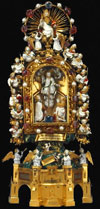items » chapel goods
Chapel goods
A very large amount of gold and silver plate was in the charge of the dean of Richard II's household chapel. It had been accumulated over the whole course of the reign, following the same pattern of growth as Richard's secular plate. Some objects had been inherited. Many were gifts, and the names of the English and French donors are given. The chapel goods supplied for Isabelle of France in her trousseau are included at the very end of the list. Others had been seized in 1397 from the Lords Appellant, when they were condemned as traitors. There is no indication of what was currently in use for either the king or queen.

The upper chapel of the Sainte-Chapelle, Paris. Illumination on vellum, signed MB 1837. After f. 83v of the Benedictional, c. 1430, burnt in 1871 (Paris, Musée de Cluny)
Larger image (77KB)
The listing of the chapel goods occupies twelve whole membranes of the treasure roll. It consists of over three hundred and twenty entries. Most objects were gold, entries 886 to 1044, many set with gems. The others, entries 1045 to 1062, were mostly of as silver-gilt rather than silver. Other materials mounted in precious metal include an amber statuette of the Virgin and Child, an ivory tablet, probably a diptych, and various objects exploiting the translucent qualities of beryl or rock-crystal.

Crucifix with the arms of the Hédervári family of Hungary, c. 1330, silver with gilding and translucent enamels, Sienese? (London, British Museum)
Larger image (19KB)
Every type of vessel needed for the celebration of the daily mass and offices was to be found. So too were objects required for other sacred rites, for example containers for oil to anoint a dying person. Crosses and crucifixes were made either to stand on the altar or to be carried in procession. Some could be adapted for both purposes. There were holy-water buckets and sprinklers, incense boats, pairs of basins for the priests' ritual handwashing, cruets for the water and wine, chalices and patenspaten - shallow dish or plate on which the bread is laid during the celebration of the Eucharist and usually made to match a chalice for the sacred elements (bread and wine), sacring bells, paxespax - tablet of precious metal, ivory, etc., decorated with a sacred image, for transferring the kiss of peace at the mass from the celebrant to the clergy and laity for the kiss of peace, pyxespyx - small container for the consecrated host, usually a round ivory or metal box and ciboriaciborium - receptacle to safeguard the host (bread consecrated during the mass) to store the consecrated bread. Besides all these were the lights, candelabra and lamps, lecterns and book covers of precious metal for the Gospels and Epistles. The quadrant would have enabled the members of the chapel to tell the time by the sun.

The Holy Thorn reliquary, Paris, c. 1400 (London, British Museum: Waddesdon Bequest)
Larger image (48KB)
There were also little devotional tablets as well as large reliquaries. Some were very elaborate, on the scale of the Holy Thorn reliquary. The dazzling valuable images of saints given by the king of France and the Valois dukes (see Image of St Michael and Edward and Edmund) were also kept with the the chapel goods. Some of these objects were decorated with Richard's arms and badges in a variety of techniques. There was a special emphasis on two of his chosen saints: St John the Baptist and Edward the Confessor (see the Wilton Diptych).
Certain items among the chapel goods would perhaps have been reserved for the use of a visiting bishop or abbot. Such were a mitre, a pontifical ring and a pair of gem-encrusted gloves for a bishop. On investigation, although the treasure list itself does not reveal this important fact, these objects turn out to be part of an especially rich haul seized from the chapel of the king's uncle, Thomas of Woodstock, when he was condemned as a traitor in 1397 (see Lords Appellant). This is a reminder that it is always important to be certain that objects were either ordered by Richard or chosen deliberately for him before trying to draw any conclusions about his patronage or personal taste.
Chapel goods are listed on membranes 29–40 of the treasure roll.
